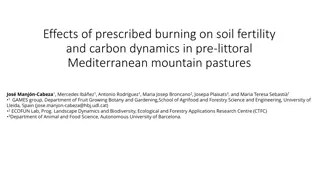
Anthrax: A Soil-Borne Disease Overview
Explore the world of Anthrax, a soil-borne disease caused by Bacillus anthracis, as presented by Prof. A. S. Mane from Deogiri College, Aurangabad. Learn about its incubation period, transmission to humans, symptoms, diagnosis, and treatment. Discover how soil, home to various biodiversity, can also harbor disease-causing microorganisms like bacteria, viruses, fungi, and protozoa. Uncover the origins of Anthrax, its life-threatening nature, and transmission methods to humans. Dive into the history of Anthrax's discovery by Robert Koch and understand its effects and treatment options in detail.
Download Presentation

Please find below an Image/Link to download the presentation.
The content on the website is provided AS IS for your information and personal use only. It may not be sold, licensed, or shared on other websites without obtaining consent from the author. If you encounter any issues during the download, it is possible that the publisher has removed the file from their server.
You are allowed to download the files provided on this website for personal or commercial use, subject to the condition that they are used lawfully. All files are the property of their respective owners.
The content on the website is provided AS IS for your information and personal use only. It may not be sold, licensed, or shared on other websites without obtaining consent from the author.
E N D
Presentation Transcript
Topic Topic Anthrax (a soil borne disease) Presented Prof. A. S. Mane Department of Environment Science Deogiri College, Aurangabad Presented by by
Soil borne disease. Anthrax introduction. Incubation period Transmition to human beings. Symptoms Diagnosis Treatment
Soil are home to a remarkable array of biodiversity. About 25% of the earths species find their home in soil. The vast majority are not of any threat to human health, however soil also contain microorganisms which are capable of causing disease.
These are those disease which are caused by the pathogenic microorganisms mostly present in the soli. The micro organisms that causes disease include bacteria, protozoa, fungi, virus etc. Bacteria virus fungi
Anthrax is a life threatening infectious disease that normally infects animals especially ruminants(goat, cattle, hoarse etc. Anthrax disease is caused by a Gram +ive ,spore forming, rod shaped bacteria Bacillus anthraces .
The bacteria was first identified by Robert Koch. Anthrax is derived from a Greek word anthrax means coal. As in cutaneous anthrax the spot enlarge with a coal like rusty covering.
The incubation period between contact with anthrax bacteria and the start of symptoms may be relatively short from 1-5 days or may be up to 15 days.
Anthrax can be transmitted to human by three ways; I. Cutaneous Anthrax; infection through direct contact of skin wound or cut to contaminated animal or soil.
Red brown raised spots that enlarges with considerable redness around it. Blistering and hardening of spot. Muscle ache, fever, nausea and vomiting. Death may occur if patient do not receive appropriate treatment.
Through inhalation of the bacterium infect respiratory track especially alveoli of lungs.
The first symptoms are flu like (influenza). In a few days however the illness worsen and there may be severe respiratory distress. Shock, coma, and death may occur.
Cause through ingestion of the bacterium, it affect the entire gastrointestinal track (mouth to intestine) From the intestine it enters into the blood stream and infect the whole body.
Nausea, loss of appetite, bloody diarrhea. Fever followed by abdominal pain. The bacteria invade through the bowel wall, then infection spreads throughout the body through Blood stream with deadly toxicity.
The bacteria may be found in culture or s in smear anthrax . In case of pulmonary anthrax found I throat swabs and sputum ,chest x-ray may also show characteristic changes in and between the lungs. Bacteria can be seen in blood stream if anthrax is deliberately spread.
The cutaneous form of anthrax can be treated with common antibiotics such as penicillin, tetracycline erythromycin and ciprofloxacin. The pulmonary form of anthrax is a medical emergency. Intervenes therapy with antibiotics may be life saving. For the prevention of anthrax vaccine should be given especially for the people at high risk (veterinarians, lab . Technicians etc.)






















